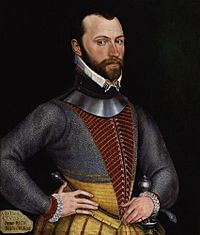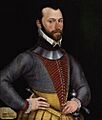Richard Bingham (soldier) facts for kids
Sir Richard Bingham (1528 – 19 January 1599) was an English soldier and naval commander. He worked for Queen Elizabeth I during the Tudor conquest of Ireland, a time when England was trying to take more control of Ireland. He became the governor of Connacht, a province in western Ireland.
Quick facts for kids
Sir
Richard Bingham
|
|
|---|---|
 |
|
| Governor of Connaught | |
| In office 1584–1597 |
|
| Monarch | Elizabeth I |
| Preceded by | Nicholas Malby |
| Succeeded by | Conyers Clifford |
| Member of Parliament for County Roscommon |
|
| In office 26 April 1585 – 14 May 1586 |
|
| Succeeded by | Sir John King |
| Marshal of Ireland | |
| In office August 1598 – 19 January 1599 |
|
| Preceded by | Henry Bagenal |
| Succeeded by | Richard Wingfield |
| Personal details | |
| Born | 1528 Dorset, England |
| Died | 19 January 1599 (aged 70) Dublin, Ireland |
| Spouse | Sarah Heigham |
| Children | Martha Bingham |
| Profession | Soldier, Naval Commander |
| Military service | |
| Allegiance | |
| Branch/service | |
| Years of service | 1547–1599 |
| Rank | |
| Battles/wars | |
Contents
Sir Richard Bingham: Soldier and Governor
Early Life and Military Adventures
Richard Bingham was born in Dorset, England, in 1528. He was the oldest of three brothers. Not much is known about his early life. However, he started his military career before he was twenty years old.
In 1547, he joined an English army expedition into Scotland. A decade later, he fought with the Spanish army against the French in the Battle of St. Quentin. In 1558, he also took part in a naval trip to the Western Isles of Scotland.
Bingham later fought in the Fourth Ottoman–Venetian War. He served with the Spanish and Venetians. He helped try to save the island of Cyprus. He also fought in the important naval Battle of Lepanto in 1571.
After this, he spent two years in the Low Countries (modern-day Netherlands and Belgium). He sent important information back to Queen Elizabeth's secretary, Lord Burghley. In 1576, he tried to make peace between different groups. When peace talks failed, he fought bravely in the Battle of Rijmenam. The Queen gave him money each year for his military and diplomatic work.
In 1579, Bingham was sent to Ireland to help stop the Second Desmond Rebellion. This was a major uprising against English rule. In 1580, he was a ship captain. He was involved in a difficult event at Smerwick. Many Italian and Spanish troops who had surrendered were killed there.
In 1583, Bingham was given a special task. He was to catch pirates in the seas near England. The Queen also secretly told him to seize Dutch ships. This was to collect debts owed to her, using the excuse of looking for pirates.
Governor of Connacht: A Challenging Role
In 1584, Bingham was made governor of Connacht, a province in Ireland. This job caused him a lot of trouble throughout his career. His brothers, George and John, helped him. Bingham was knighted in Dublin Castle in July 1584.
The "Composition of Connacht" was a plan in 1585. It aimed to make local Irish lords pay regular taxes to the English crown. However, by 1586, Connacht was in a widespread rebellion. Bingham oversaw court cases in Galway. Over 70 people were sentenced to death for disloyalty. He also captured Castle Cloonoan and defeated its defenders.
The MacWilliam Burke clan in County Mayo were key leaders of the rebellion. Bingham entered their lands. He captured Castlehag and agreed to leave if the locals fought the rebels. In 1585, he took three young Burke boys as hostages. They were later executed.
The costs of the rebellion were covered by taking cattle and collecting fines. Bingham took some of the Burkes' land. He gave Castlebarry to his brother John. The leader of the Burkes, Edmund Burke, was executed in 1586. By August 1586, peace was made with most rebels in Connacht.
Bingham also had to deal with 3,000 Scottish fighters. They had crossed into Ireland from Ulster. He surprised them at Ardnaree in September. The Scots were defeated, and many were killed or drowned in the river. Bingham's brother John fought bravely in this battle.
Some people complained about Bingham's actions. They said he had caused the rebellion. However, many local gentlemen signed a statement. They said the rebellion was caused by changes to their traditional leadership. The charges against Bingham were dismissed in 1587.
By the end of Bingham's first time as governor, Connacht was said to be doing well. It produced food for other areas. People even moved there from other parts of Ireland.
Dealing with the Spanish Armada
In 1587, Bingham left Ireland to serve in the Netherlands. His brother George took his place in Ireland. In 1588, Bingham discussed England's defense against Spain. He also got married for the first time in January 1588.
Bingham returned as governor of Connacht later in 1588. When the Spanish Armada was defeated, many Spanish ships were wrecked off the Irish coast. Bingham ordered that Spanish sailors who survived shipwrecks be captured. Many of these survivors were killed under his command. His brother George also killed many Spanish survivors.
The presence of Spanish survivors caused more unrest among some Irish clans. In March 1589, a new rebellion began. It was led by the "Blind Abbot" of the Burkes. The English Lord Deputy, William Fitzwilliam, intervened. He ordered Bingham to withdraw his forces from Mayo.
A peace meeting was set up in Galway. Bingham was in charge. However, most rebels did not attend. The province was in chaos. Bingham continued to fight the rebels. He drove one leader, Brian O'Rourke, north into Ulster.
Fitzwilliam wanted to blame Bingham for the rebellions. He ordered Bingham to stay in Athlone. Fitzwilliam went to Galway to meet the rebels. They made many complaints against Bingham. These complaints were sent to England. Bingham's power to use martial law was temporarily stopped.
The situation in Connacht remained unstable. However, Bingham was eventually cleared of the charges against him in December 1589. He returned to Connacht. He continued to fight the rebels, burning crops and villages. The rebels eventually asked for peace. Bingham's forces defeated O'Rourke, who fled to Ulster.
Later Years and Legacy
In 1592, John Perrot, a former Lord Deputy, complained about Bingham. He said Bingham was too harsh. However, Perrot himself faced accusations. Bingham helped with the case against Perrot. Perrot was found guilty of treason and died in the Tower of London.
In 1592, a group of Burkes rebelled again. Bingham forced them to pay fines and cover war damages. Connacht was quiet until 1593. Then, Hugh Maguire and Brian Óg O'Rourke raided Sligo. Bingham's forces fought back.
In 1594, Bingham's cousin, Captain George Bingham, attacked Enniskillen Castle. The castle was captured, and many defenders were killed. Bingham was ill at the time. Later, the castle was retaken by Irish forces.
In 1595, Bingham's cousin George was killed by one of his own men. Sligo Castle was then given to Hugh Roe O'Donnell, a powerful Irish leader. Bingham tried to retake the castle but failed. He had few resources to fight O'Donnell.
New complaints were made against Bingham. He went to England in 1596 to appeal for justice. He was briefly held in prison but released due to illness. He was suspended from his job.
In 1598, the Nine Years' War (another major rebellion) was getting worse. Bingham's knowledge of Ireland was suddenly seen as very valuable. He was appointed Marshal of Ireland and general of Leinster. He left England with 5,000 troops. However, he died shortly after arriving in Dublin in January 1599.
Bingham married Sarah Heigham in 1588. They had one daughter, Martha. He had no sons. His nephew, Sir Henry Bingham, 1st Baronet, inherited his property. A memorial was built for him in Westminster Abbey.
Bingham is remembered for his harsh rule in Connacht. He was seen by some as a cruel governor. However, his supporters say he always acted within his authority.
Images for kids


